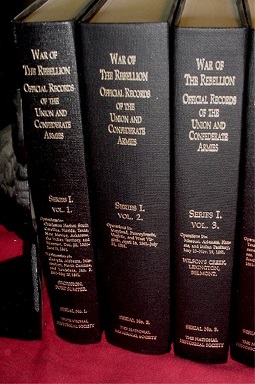The Narrative of a Blockade Runner
by Capt. John Wilkinson
This is the only volume in the Time Life Collector's Library that deals with the Navy in the Civil War. The editors chose well. Wilkinson's book is a tale of personal victory buried in the overall tragedy of a crumbling South. The book is well written and provides great insight into the maritime activities of the confederate states and union opposition to those activities along the east coast. Still this book is primarily about running the blockade against dangerous Yankee warships. Wilkinson, through a combination of excellect seamanship and luck, not only outwitted his pursuers but avoided the shoals and reefs of the dangerous Southern shore. The chapters that focus on running between Charleston, SC, and the Bahamas and between Wilmington, NC, and Bermuda are most engaging. He was the leader of a daring raid to free thousands of Confederate prisoners of war on Johnson's Island, in Lake Erie, and was often within sight of the shores of Long Island when he raided enemy merchant ships.
Wilkinson writes of the fall of New Orleans:
Farragut passed the forts as stated,
with the Hartford and one or two other vessels, destroyed the ram
Manassas, and the other Confederate vessels of war, after a most
desperate battle, in which at least one of his best ships was sunk, and
then made his way in his flag-ship unmolested up the river. He arrived
alone in front of New Orleans on the 26th of April, and at noon brought
his guns to bear on the city at the head of Girod street. He immediately
dispatched Lieutenant Bailey with a flag of truce to the authorities
demanding the surrender, and giving them thirty-six hours in which to
reply,--at the expiration of which time he should open fire and bombard
the place, if an answer favorable to his demand were not received. The
city at this time had been partially evacuated by General Lovell and his
troops, and all authority had been surrendered by the military to the
mayor. The terms submitted by Farragut were discussed for fully
twenty-four hours by the Council, assembled at the Mayor's office, and
all this time the city was in the hands of a wild, reckless and excited
mob of citizens, while people everywhere were flying or preparing for
flight, many even in such haste as to leave their houses open and
valuables exposed to the depredations of servants or the mob. Perhaps no
more fearful scene of confusion was ever witnessed outside of Paris when
in the throes of a periodic revolution. It was a novelty then for an
American city to be captured or to fall into the hands of an enemy, and
the people had some very queer notions about defending it to the last,
and fighting the enemy with all sorts of weapons amid its ruins. It was
with the utmost difficulty the police could protect Bailey and his
middies with their flag of truce. But on the following day, and before
the time of grace expired, the Council determined that as they had no
means of defence against the enemy's ships, which held the city at the
mercy of their guns, it was best to enter into negotiations for the
surrender. Farragut then demanded that as a sign of submission the
Confederate flag should be hauled down from all points where displayed
in the city and replaced by the stars and stripes, and in the meantime
he would send a battery with his sailors and marines ashore to maintain
order. But no one was found in the city to take the Confederate flags
down, and hoist the starry banner in their place; so a battery of ships'
guns was landed and hauled through the streets till it reached the City
Hall, and there it was placed in position to cover every point of
approach. A young middy, apparently about fifteen years of age, then
made his appearance at the entrance of the City Hall, bearing a United
States flag. He was admitted without opposition, and was shown the way
to the top of the building. The lad ascended to the roof, and in full
view of an assembled multitude of thousands in the streets and on the
housetops, deliberately undid the halyards and hauled down the
Confederate, or rather Louisiana State flag; then replacing it with the
one he carried, hoisted it to the peak of the staff in its place, and
the capture of New Orleans by the navy was complete. Many who witnessed
the act of this daring boy trembled for his life, as a rifle shot from
any of the houses surrounding, or even from the street, would have
proved fatal and put an end to his young life at any moment. So excited
was the crowd in the street, when the middy came down, and so fierce the
thirst for vengeance upon any object that might present itself, that it
was found necessary to hurry him into a close carriage and drive with
all speed through back streets, to keep clear of the pressing mob, who,
in the blindness of their passion, would perhaps have sacrificed the
youngster, had they caught him, to appease their rage.
Born in Norfolk, Virginia in 1821, John Wilkinson entered the U.S. navy as a midshipman in 1837. He resigned his commission as a lieutenant in April 1861, and accepted the same rank in the Confederate service. Wilkinson, like many other naval officers who had left the United States Navy to join the Confederacy, found himself without a ship and was thus assigned to the command of a naval battery at Ft. Powhatan, on the James River near City Point. When the fort was abandoned, Wilkinson was transferred to another battery above Acquia Creek on the Potomac River. In the spring of 1862, Wilkinson was ordered to the river fleet assembling near the forts Jackson and St. Phillip below New Orleans. He was appointed executive officer of CSS Louisiana, an incomplete ironclad. His description of this vessel and its subsequent trial of fire and untimely death is illuminated with an explanation of the many difficulties encountered with this vessel, including ill-cut gun ports and a woeful lack of manpower. After being forced to scuttle the Louisiana, Wilkinson was captured and sent to Ft. Warren where after a few months he was exchanged. He writes kindly of his treatment in the time before the Union stopped the exchange program.
On his parole, Wilikinson went to England to command the blockade-runner Robert E. Lee, one of the most successful of the war. Many of his deceptive tactics were adopted by other blockade-runners, and became standard practice. He later commanded the raiders Chickamauga and Chameleon. He lived in Nova Scotia for a while after the war before returning to Virginia, where he died in 1891.
As Wilkinson writes at the very beginning, this books is more than an adventurous tale of running the dangerous Federal blockade. It is also a record of Civil War Nassau, Bermuda, and Cuba and the southern sympathies of the inhabitants--primarily black--of these areas. It is also a tale of the fall of New Orleans through a combination of unpreparedness, incompetence, pigheadedness and overt treason. Wilkinson tells of his short and successful career as a merchant raider including the fact that--because of the success of Southern merchant raiders -- Federal warships were virtually the only Unionist vessels afloat by the end of the war. This suggests, of course, that had the South been able to emphasize merchant raiding even more, it might have embargoed the North as tightly as the North blockaded the South.
The editors at Time-Life chose this book as one of the volumes of the Collector's Library of the Civil War. It is available in a leather-bound edition with gilded gold edges and also in paperback and digital formats. It is included as one of the volumes on the DVD of our Collector's Library set.

























